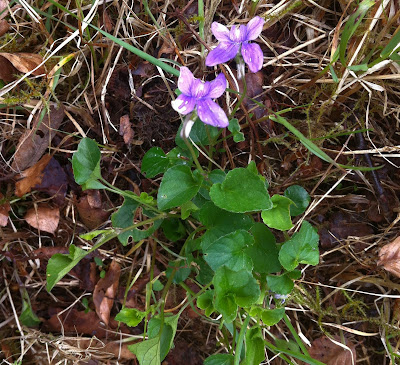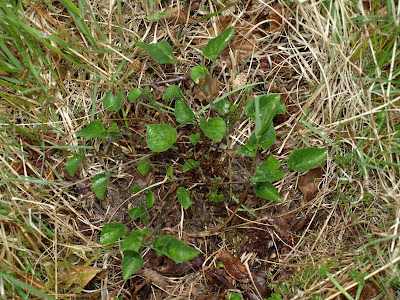Free excerpt
CHAPTER 1: Introduction
This book contains plants that I found in my garden which tasted good and were fairly easy to use. Since there are so many edible wild plants available I wanted to list those that I use most often to help others make the transition to eating wild plants much easier. There are a lot of plants that you can eat but, to be brutally honest, there are some that you really wouldn't want to!
I initially found these plants in my suburban garden in the south east of England and more recently on the land of a small holding in rural Scotland. I realise I am quite lucky in that my current foraging area is large and contains a variety of habitats including woodland with mature beech trees, moorland with gorse and a riparian area where I can find plants like marsh pennywort. However, most of the plants I use regularly are actually found near the house.
Looking close to home for your plants will encourage regular use. If you have to make a 50 mile round trip every time you want to eat a wild plant, you will soon tire of the whole foraging thing whether you like doing it or not. The easier you make the job of wild foraging the better. So remember the three 'F's: Forage From your Front door.
The first place to look for wild plants is always always always in your own garden. If you haven't got a garden, try those of your neighbours, relatives or friends. Most will be eternally grateful if you remove what they consider to be weeds. I'll go with the assumption that you've got yourself a garden. If you're looking out the window at this garden and the grass is mown short, the flower beds only contain flowers recently planted from the garden centre and there isn't a dandelion in sight, do not despair. Hope and wild plants spring eternal!
The first thing you need is a little time to let the wild plants grow and to learn to go a little bit wild in your mind. The most important thing is to let go of social conventions and brace yourself for any strange looks or comments from the neighbours. Even today, with all our talk of being green and looking after the planet, copious amounts of weed killer and slug pellets are still the norm. People simply refuse to let wild plants grow and generally try to make their gardens look like the inside of their house; all clean and tidy. Everything in a garden should not be shoved away, swept up and wiped down.
If you have an immaculate garden and are worried that you will never be able to find anything to eat, all is not lost. Remember how those so-called weeds kept coming back even though they were relentlessly removed? Week after week they kept coming up especially in the summer. It was a nightmare wasn't it?! That is all about to change. Now you need to look on these plants as a good rather than a bad thing. You need to stop weeding. It can be done in stages to ease you into it without too much anxiety. Begin by leaving a couple of metres at the end of the back garden to go wild. You could then move on to any formal beds you have. The ultimate challenge is probably letting the lawn grow. It's not easy to do, especially in a residential area where the pressure is on to give all lawns a number one buzz cut. This probably doesn't need to be said but do keep in mind that these plants are not only good for you, they are also good for wildlife.
The first time I let my front lawn grow instead of mowing it was over ten years ago and it was a very hair raising experience. It already contained a lot of plants other than grass because my dad never used weed killer on the lawn in 60 years. I think he resented paying for the weed killer rather than objecting to the danger of using chemicals! Anyway, I knew the plants were there. Hell, I could see them. Tiny little leaves that belonged to plants which hadn't been allowed to grow to their full potential in years!
The house was detached and the front lawn quite large. More importantly everyone in the neighbourhood could easily see it. Could I do it? Yes, but it took a while to pluck up the courage. Quite a few plants came up in that first showing including yarrow, clover, hawkweed, daisy, violets, cat's ear, ox eye daisies and the ubiquitous dandelion. The latter probably caused my neighbours more stress than anything else because I knew they really didn't want the dandelion seeds floating away on the wind and seeding their immaculate lawns which only contained one species ie. grass.
As a concession to the neighbours' nerves, the lawn was cut once the flowers got to the point of seeding. On a few occasions it didn't get mowed in time, I snuck out in the early hours of the morning and removed the seed 'clocks' by hand, shoving them unceremoniously into a polythene bag before ducking back in the front door. The neighbours, give them their due, didn't utter a word about the dandelions but I just knew they were relieved when I finally moved out.
If you can't find what you are looking for you can buy seeds, plug plants and larger potted plants from specialist nurseries on line. Do not shy away from growing your own foraging. It is not unnatural or something to be ashamed of. Search online for native wild flower sellers or organic herb nurseries as a starting point. I began sowing chickweed seed in my polytunnel for a fresh supply of wild salad greens. Once it became established I didn't need to do a thing. Chickweed self seeds readily and will come up quickly. It is one way of getting a reliable supply of fresh salad greens throughout the year.
While this book lists the wild plants I use, you will inevitably find others. I could list them all but the list is long and others have already completed this labour of love. Look out for blogs like Raw Edible Plants or organisations like Plants for a Future who maintain a wonderful online database of useful plants including how to identify them and eat them. This book, therefore, is not a comprehensive listing of edible wild plants but a starting point for your edible journey. Perhaps, if you are already on this journey, you will find a few things to add to your knowledge base. There are a great deal of wild plant enthusiasts around these days. They have books, blogs and online videos espousing recipes and recommended ways of using wild plants. Round of applause to them all. Be sure to check them out.
The following chapters comprise of plants that are relatively easy to find and don't take too much processing to make into something half decent to eat or drink. I've started off with the ones that are easier to find and that you might know already. As with all wild edible plants, check the Latin name when identifying them rather than use the common name as this is more accurate. Enjoy!
CHAPTER 2: Stinging nettles
The stinging nettle (Urtica dioica) is one of my favourite plants because it screams 'stay away' and yet is one of the most useful plants found in temperate regions of the world. An herbaceous perennial from the Urticaceae family, it is known by many different common names throughout the world such as leaf nettle, common nettle, burn nettle, burn weed, burn hazel or just plain 'nettle'.
Robe up before you go in search of this little beauty. Any flesh showing will almost certainly come into contact with the tiny hairs made of silica called trichomes that break off easily dispersing a cocktail of chemicals into your body which include formic acid, histamine, acetylcholine and serotonin. These chemicals cause a stinging pain and ensure you suffer for hours afterwards with a tingly irritating numbness. Remedies for the sting include dock leaves, plantain leaves and calamine lotion but I can't guarantee any will be truly effective.
If you don't have any nettles in your garden, you can dig up a small clump of root and replant them. Nettles are considered invasive and difficult to get rid of so woe betide me for suggesting doing this. However, I don't think being labelled an 'invasive weed' is any reason not to grow a very useful edible plant. We spend far too much time eradicating plants that we should really be making use of.
Nettles grow to just over a metre in height with white to yellowish flowers but are best picked before they grow tall and flower. If you've got a good patch you can cut them down when they are about 30cm in height and let them grow again. This can be done three or four times a year or more under the right conditions. Remember the taller they get, the more tough and stringy they are. Also remember that this plant is good for wildlife attracting butterflies and moths so leave some plants to fully mature and flower. The tops of this plant will die down in the winter but it is a tough perennial and will emerge ready to go again in the spring.
The leaves, younger stems and the shoots can all be eaten raw. Use a clean glove and roll them tightly crushing them well before popping them in your mouth. This removes the sting. Other ways of removing the sting include wilting, blending, refrigerating, cooking and making a tea from them. I have to say I don't relish eating these little raw balls but prefer to add the fresh plant material to green smoothies or use to make a herbal tea. If you have any tea over it can be used as a hair rinse. My overwhelmingly favourite way of using the leaves, stems and shoots is by cooking them lightly in a little water and using like spinach. They have a nice mouth feel and are much less slimy. You can add fried onions, chickpeas and spices to make a type of spinach saag. Another age old favourite is, of course, to use nettles to make soup. A plentiful supply of nettles in your garden is a cheap and nutritious way of getting your daily greens.
Nettles have a lot of other uses. They make a good fibre which is created by stripping the outer stems. These stringy strips are then dried and spun into a yarn. Nettle yarn can then be knitted up or woven into a fabric. It is a long and somewhat fiddly process. Nettles are very beneficial medicinally but can also be used to make paper, biomass, compost/plant feed/compost activator, dye, rennet and oil.
My favourite ways to use nettle: The young leaves and stems made into a tea, added raw to green smoothies or cooked like spinach.




























